Does anyone know of color maps, arrays of say 50 colors, that
- can be read to high accuracy -- adjacant colors distinguishable by eye
- are visually pleasant ?
For example, the bottom color map under Matplotlib qualitative colormaps
is pleasant, but has only 20 bands. Can one get up to 50 bands, to read off height to within +- 2 % ?
("Visually pleasant" is somewhat, but not only, a matter of opinion;
there are objective criteria, from a tradition of map-making that goes back for centuries.
Here, the goals "50 bands" and "pleasant" conflict.)
Added: here are plots of some colormaps quantized to 20 bands, 4 "perceptually-uniform" from matplotlib and 20-odd from cmocean, "beautiful colormaps for oceanography". It shows that even 20 bands are hard to distinguish where they're dark:
 For real data, other factors will be more important than colormap alone:
interactive, e.g. zoom in with adaptive colormaps ?
Histogram equalization ?
For real data, other factors will be more important than colormap alone:
interactive, e.g. zoom in with adaptive colormaps ?
Histogram equalization ?
